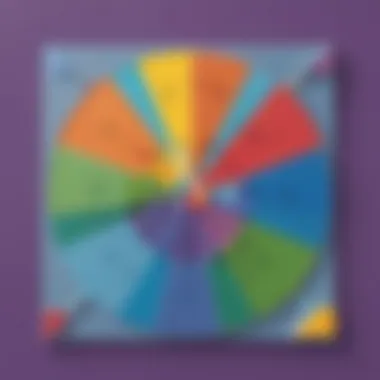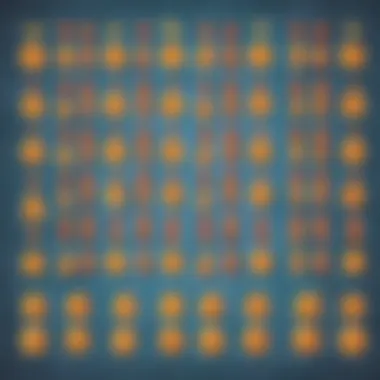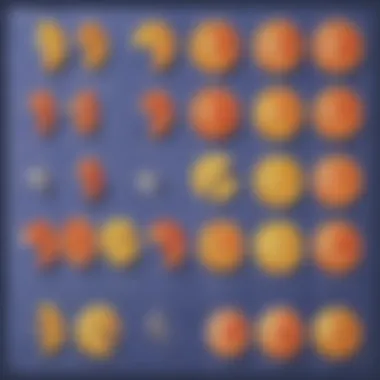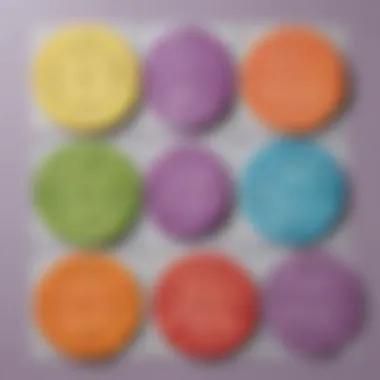Mastering the Art of Multiplying Fractions


Intro
Multiplication of fractions is a fundamental mathematical concept that often challenges young learners. Grasping this concept lays the groundwork for more complex mathematical understanding in the future. In this article, we will explore how to multiply fractions effectively while addressing potential misconceptions, providing engaging teaching strategies, and practical example that can illuminate the topic for students.
Understanding how to multiply fractions is crucial as it extends beyond mere numbers. It promotes logical reasoning and analytical skills, which are essential in everyday life as well as academic settings. Moreover, math is often perceived as a daunting subject by many, hence the need for effective techniques to make it more accessible and enjoyable for children.
Through this guide, we aim to equip educators, parents, and caregivers with valuable resources and insights to enhance their teaching methods. The inclusion of hands-on activities and interactive learning games plays a significant role in fostering a rich learning environment.
Interactive Learning Games
Popular Games
Using educational games can transform the learning process, turning abstract concepts into engaging activities. These games often reinforce the basics of multiplying fractions while ensuring students remain engaged. Popular games include:
- Fraction Tiles
- Math Bingo
- Fraction War
Each game offers a unique approach to learning and helps students visualize fractions in an enjoyable manner.
Description of Top Educational Games
- Fraction Tiles: These allow children to manipulate fractions physically, giving them a visual representation of multiplication.
- Math Bingo: Children solve fraction multiplication problems to fill in their bingo cards, making it competitive and fun.
- Fraction War: A card game where kids draw cards and multiply fractions, promoting quick thinking and strategy.
Benefits of Playing Educational Games for Kids' Cognitive Development
Playing educational games can significantly enhance cognitive development in children. Some key benefits include:
- Improved problem-solving skills.
- Enhanced memory retention.
- Increased engagement and motivation to learn.
Educational games make learning concepts like fractions less intimidating and more interactive, paving the way for deeper understanding.
Game Reviews
In-Depth Reviews of Selected Educational Games
- Fraction Tiles Review:
These colorful, physical tiles help children visualize fractions easily. Users appreciate how tactile learning aids retention among students. - Math Bingo Review:
Teachers report that Math Bingo effectively involves large groups while reinforcing fraction multiplication. It also encourages teamwork and social interaction. - Fraction War Review:
This game is praised for its quick pace, allowing children to practice their fraction multiplication skills frequently and dynamically.
Comparison of Gameplay and Learning Outcomes
While all games have their advantages, Fraction Tiles provide the best visualization, aiding in conceptual understanding. In contrast, Math Bingo excels in group engagement, while Fraction War enhances speed in recalling multiplication facts. The blend of these games can cater to different learning styles and preferences, ensuring comprehensive understanding.
Educational Topics
Mathematics is just one part of a broad educational spectrum. A compilation of articles covering subjects like science, language, and art can promote interdisciplinary learning, enriching children's overall development. For educators, linking concepts across different subjects can create a more cohesive learning experience, nurturing critical thinking.
Tips and Tricks
Practical Tips for Parents and Educators
- Use Real-Life Examples: Relate fraction multiplication to real-world scenarios like cooking or shopping.
- Encourage Questions: Foster an environment where children feel comfortable asking questions about difficult concepts.
- Practice Regularly: Frequent, low-pressure practice can help reinforce skills without overwhelming students.
Strategies for Making Learning Fun and Engaging
- Incorporate technology, such as educational apps and websites that promote interactive learning.
- Create a relaxed atmosphere that emphasizes collaboration and exploration, rather than competition.
Creative DIY Projects
Step-by-Step Guides
Hands-on activities can promote creativity while reinforcing skills in multiplication. Here�’s how to create a simple Fraction Pizza project:
- Gather materials like paper plates and markers.
- Have children illustrate a pizza divided into fractions.
- Discuss how multiplying fractions applies to adding toppings (e.g., one-half of one-third of a pizza) adding a flavor of fun to the process.


Craft Ideas
Using simple household items for creative crafts can reinforce the concept of fractions through artistic expression. For example, children can use colored paper to create fraction bar models or pie charts, visually representing different fractions.
Artistic projects not only help in understanding fractions but also support fine motor skills and imaginative thinking, crucial for holistic development in children.
Prologue to Fractions
Understanding fractions is essential to grasp more complex mathematical concepts, including multiplication of fractions. Fractions are foundational elements in mathematics that appear in various contexts, such as measurements, ratios, and proportions. By learning about fractions, young learners develop critical thinking and problem-solving skills that are vital for their academic growth. Educational resources focusing on fractions help individuals gain confidence in their mathematical abilities.
What is a Fraction?
A fraction represents a part of a whole. It is made up of two components: the numerator and the denominator. The numerator indicates how many parts are taken, while the denominator shows the total number of equal parts in the whole. Understanding what a fraction is forms the basis for performing operations like addition, subtraction, and specifically multiplication of fractions.
Types of Fractions
Fractions are not all the same. They can be classified into three main types:
Proper Fractions
Proper fractions have numerators that are smaller than the denominators. For example, in the fraction 3/4, the numerator is 3, which is less than the denominator 4. This type of fraction is beneficial because it clearly represents a part of a whole, giving learners an intuitive understanding of how fractions function. The key characteristic of proper fractions is their ability to simplify concepts related to division and part-to-whole relationships.
Improper Fractions
Improper fractions are those where the numerator is greater than or equal to the denominator. An example is 5/3, where 5 is more than 3. These fractions are useful in understanding scenarios where a whole number is exceeded. They offer insight into division and can easily be converted into mixed numbers. The core aspect of improper fractions lies in their representation of quantities greater than one, making them unique in mathematical discussions.
Mixed Numbers
Mixed numbers combine a whole number and a proper fraction, such as 2 1/2. This type of fraction is particularly relatable for learners because it indicates both a whole part and a fractional part. Mixed numbers are advantageous in real-life applications like cooking and construction, where both whole quantities and parts are relevant. By grasping mixed numbers, students gain a better understanding of how numbers work in practical situations, linking math with everyday life.
Learning about different types of fractions equips students with the skills to tackle fraction multiplication effectively.
In summary, introducing fractions not only covers what they are but also the various types. Understanding these foundational concepts is crucial for deeper exploration into fraction multiplication. This knowledge facilitates a smoother transition into more complex mathematical operations.
Understanding Multiplication
Multiplication, as a foundational concept in mathematics, is essential not just in the context of whole numbers but also in operations involving fractions. Understanding multiplication helps learners see the relationships between numbers. When it comes to fractions, this understanding becomes crucial as the operations are a bit different from those involving whole numbers. By mastering multiplication, students can tackle more complex mathematical problems with confidence.
The importance of multiplication transpires in its ability to simplify problems and create clarity in calculations. For students, grasping these ideas encourages them to think more abstractly about numbers and their interactions. This, in turn, builds a strong base for more advanced math concepts, critical for their overall academic success.
The Concept of Multiplication
Multiplication serves as repeated addition. When we talk about multiplying two numbers, we are essentially adding one number to itself a specified number of times. For instance, multiplying 3 by 4 means we are adding 3, four times. In the fraction context, multiplication requires understanding how numerators and denominators interact, which is slightly more complex.
Multiplication in Mathematical Terms
Factors
Factors refer to the individual numbers that are being multiplied together to produce a product. In the case of fractions, the numerators and denominators are both treated as factors. The key characteristic of factors is their role in creating products. When discussing fractions, each fraction's numerator and denominator can be viewed as factors contributing to the multiplication process.
The significance of understanding factors lies in their contribution to simplifying multiplication. Generally, when multiplying fractions, the factors combine straightforwardly without needing additional steps. This clarity makes factors a beneficial element to highlight in this article as they simplify students' understanding of how multiplication functions with fractions.
The unique feature of factors is how they can demonstrate part-to-whole relationships which is crucial in understanding fractions. One potential disadvantage can be that without robust familiarity, students can struggle to identify factors in more complex fractions.
Products
The product is the result of multiplying two or more numbers. It embodies what is achieved from the multiplication of factors. In fraction multiplication, the aim is to calculate the resultant fraction, which emerges from multiplying the numerators together and the denominators together. The key characteristic of the product is that it shows how two fractions interact to create a new value, preserving the concept of proportionality.
Understanding products introduces a productive approach to simplifying calculations for students. This makes explaining the procedure efficient and offers clarity on expectations when multiplying fractions. Products are essential as they provide a conceptual anchor for learners to grasp outcomes of multiplication clearly.
A unique characteristic of products, especially in fractions, is how they require attention to simplification post multiplication. While obtaining products can be straightforward, learning how to express them in simplest form often poses challenges for students. This nuance can either be a helpful learning moment or a point of confusion, highlighting the need for thorough instructional strategies.
Mechanics of Multiplying Fractions


The mechanics of multiplying fractions is a crucial topic that seeks to clarify how fractions combine through the multiplication process. This section aims to break down the multiplicative process into clear, digestible steps. Understanding these mechanics can assist learners in grasping more complex mathematical concepts later. Furthermore, emphasizing the correct procedures can minimize errors and misunderstandings many learners face when approaching fractions.
Step-by-Step Approach
Multiply the Numerators
Multiply the numerators, which essentially means you take the top numbers of each fraction and multiply them together. For instance, with the fractions 1/2 and 3/4, you would compute 1 x 3. This results in 3, which becomes the numerator of the resultant fraction.
The main characteristic of this step is its straightforwardness. It is easy to grasp, making it an ideal starting point for learners. The unique feature is that it reinforces the concept of multiplication by aligning numbers in a simple form. However, it requires consistent practice. A common mistake is forgetting to perform this step correctly, which can lead to misunderstandings in future problems.
Multiply the Denominators
After computing the numerators, the next step is to multiply the denominators. This involves taking the bottom numbers of each fraction and performing a multiplication operation with them, similar to the numerators. Continuing with the same example, you would multiply 2 x 4, which gives 8. This value becomes the denominator of the new fraction.
The key characteristic here is the consistency required between the numerators and denominators. It ensures that both parts of the fraction are handled equally. One notable feature of this step is that learners may find it challenging at first due to needing to manage more numbers. However, success in this area builds confidence in overall fraction multiplication.
Simplifying the Resulting Fraction
After multiplying the numerators and denominators, the next important aspect is simplifying the resulting fraction. An example would be turning 3/8 into its simplest form if possible. This skill improves fraction understanding and shows learners the importance of working with manageable numbers.
A key feature of simplification is ease of interpretation. A simplified fraction is typically more accessible for further calculations or applications. However, it's also a step often overlooked, as some might think the final answer is always correct without checking. Therefore, encouraging caution in this step can yield better mathematical hygiene.
Illustrative Examples
To cement the understanding of these mechanics, it helps to provide practical examples. When learners see calculations in action, they can relate more easily to the processes involved. Such examples can bridge the gap between theory and real-world application. Through stepwise illustrations and mathematical scenarios, one can demonstrate multiplication processes clearly and effectively.
"Mathematics is the art of giving the same name to different things" - Henri Poincaré.
By breaking down mechanics step-by-step, we help demystify the multiplication of fractions, making it more approachable for educators, parents, and caregivers alike.
Common Misconceptions
Misconceptions about multiplying fractions can lead to confusion and frustration for students. It is essential to address these misunderstandings, as they form barriers to achieving mastery in this area. By revealing these errors and clarifying concepts, students can have a more solid foundation. In this section, we will look closely at two prevalent misconceptions in fraction multiplication: mistakes in fraction multiplication and misunderstandings surrounding cross multiplication.
Mistakes in Fraction Multiplication
One frequent mistake occurs when students apply addition or subtraction instead of multiplication. For instance, many pupils might attempt to add the numerators together and add the denominators, producing an incorrect result. They often think of fractions in terms of shapes or pie slices, which can mislead understanding. The correct approach requires multiplying the numerators and the denominators separately.
Here are a few common mistakes students might make:
- Adding Numerators: Some students mistakenly add both fractions' numerators while ignoring the multiplication process.
- Ignoring Simplification: After multiplying, they might forget to simplify the resulting fraction, making their answer less clear.
- Misunderstanding Unit Fractions: Students may confuse unit fractions, leading to inaccurate calculations.
Each of these errors not only affects their calculations but can also detract from their enthusiasm regarding math and fractions. Identifying and addressing these issues is critical in teaching environments.
Understanding ‘Cross Multiplication’
Cross multiplication is often misinterpreted as a valid method for multiplying fractions, but this concept is primarily relevant for comparing or solving equations with fractions, not for directly multiplying them. When students employ cross multiplication, they may believe they have multiplied fractions correctly, but that is not the case.
To clarify:
- Cross multiplication involves taking one numerator and multiplying it by the opposite denominator.
- It is often misapplied in contexts where straightforward multiplication is needed.
For instance, if a student looks at 1/2 and 3/4, they may cross-multiply as follows:
- 1 * 4 = 4
- 2 * 3 = 6
They might conclude a final result of 4/6, which isn't correct in the context of multiplication. The proper method should yield 1/2 * 3/4 = (13)/(24) = 3/8.
Understanding these fundamental differences enhances accuracy in handling fractions and builds confidence in students as they work through their mathematical education.
Encouraging learners to focus on the actual procedure for multiplying fractions will lead to better comprehension. Regular practice, combined with clarification of these misconceptions, can offer a more effective learning experience.
Applications of Fraction Multiplication


Educators and caregivers can influence children's learning experiences by showing them how fraction multiplication applies to situations they encounter regularly. When students recognize that fractions are not merely theoretical symbols but tools for solving practical problems, they are more likely to engage with the material meaningfully.
Real-Life Scenarios
Multiplication of fractions manifests through numerous real-life scenarios. For example, consider someone who wants to share a pizza. If the pizza is cut into eight slices and a person eats three slices, they have consumed 3/8 of the pizza. If another person eats half of that amount, they have consumed half of 3/8, which can be found by multiplying fractions: 1/2 * 3/8 = 3/16. This shows how multiplication of fractions is not restricted to abstract exercises but reflects real actions.
Here are some additional scenarios:
- Construction Projects: When measuring materials, fractional calculations are frequent. If a builder needs 2/3 of a foot of wood but only has 1/4 of a foot piece, they need to find how much wood they have in total by multiplying.
- Gardening: If a gardener plants 3/4 of their seeds in one row and decides to use 2/3 of that row for tomatoes, they will calculate how many seeds are used by multiplying the fractions.
- Shopping Discounts: When products are marked down by fractions, like 1/4 off a price, understanding how these discounts work requires multiplying fractions to determine the savings.
These examples illustrate how multiplying fractions is integral to many daily tasks. Recognizing this connection can motivate students to practice multiplication of fractions, seeing it as relevant beyond worksheets.
Fraction Multiplication in Cooking
Cooking provides a tangible context for applying multiplication of fractions, and it can captivate children's interest in a practical and memorable way. Recipes often require precise measurements that include fractions. Thus, multiplying fractions becomes essential for adjusting serving sizes or halving or doubling recipes.
For instance, if a recipe calls for 3/4 cup of sugar and a cook wants to triple the recipe, the sugar needed is determined by 3 * 3/4 = 9/4 cups of sugar, which simplifies to 2 1/4 cups. Such calculations are common in the kitchen and encourage students to see how math is relevant to their culinary experiences.
Some additional points to consider include:
- Fraction Addition and Multiplication: For some recipes, you may first need to add fractions before multiplying, which reinforces the concept of order of operations in mathematics.
- Precision in Measurements: Missing a fraction in a recipe can lead to off results in taste or texture.
- Bonuses for Learning: Cooking offers opportunities to explore other topics, such as conversions between fractions and decimals or finding equivalent measurements.
In summary, using cooking as a context for understanding fraction multiplication creates an interactive and enjoyable learning environment. It not only reinforces mathematical concepts but allows learners to see the significance in actions they perform at home.
Enhancing Learning Experiences
Effective teaching methods play a crucial role in this learning enhancement. They cater to the diverse learning styles that students possess. For many, traditional lecturing may fail to engage or resonate. Thus, tailoring instruction to be more interactive can boost comprehension and retention. Incorporating visual aids, real-world applications, and practical examples creates an environment where students feel encouraged to explore and question.
Here are some benefits of enhancing learning experiences in fraction multiplication:
- Engagement: Involving students actively in their learning process provides a deeper connection to the material.
- Understanding: Engaging activities clarify difficult concepts, which can prevent misunderstandings that may arise from rote learning.
- Application: Understanding the relationship between fractions and real-life situations helps students appreciate the relevance of what they learn.
It is paramount that educators consider these factors to cultivate curious and capable learners.
Resources for Further Learning
Books and Workbooks
Books and workbooks stand as vital resources in the learning process. They offer structured material that covers fundamental concepts and provides exercises for practice. Here are several reasons why books and workbooks are crucial:
- Structured Learning: They present mathematical concepts clearly and logically, making it easier for young minds to grasp.
- Practice Questions: Many workbooks include a variety of exercises that reinforce the understanding of multiplying fractions through repetition.
- Supplemental Material: Some books provide additional explanations, examples, and visuals that cater to different learning styles.
For instance, "Fraction Fundamentals: Master the Art of Multiplying Fractions" is a recommended book, featuring thorough explanations and step-by-step examples.
Online Learning Tools
Online learning tools have transformed education, especially with the integration of interactive elements. These platforms offer immediate access to a wealth of information on multiplying fractions. Several benefits of using online resources include:
- Interactive Learning: Many platforms provide games and quizzes that engage learners in a fun, rewarding manner.
- Diverse Resources: Websites like Khan Academy and IXL offer video tutorials, practice problems, and instant feedback to enhance understanding.
- Accessibility: Students can access these tools anytime, making it easier to learn at their own pace.
Platforms such as Prodigy and Mathletics are particularly effective, as they gamify learning, making complex topics more approachable.
Online resources expand the learning environment, offering engaging tools that traditional methods might lack.
In summary, both books and online platforms significantly enrich the educational experience of students learning about fractions. They provide varied approaches to content, catering to different needs and learning styles. Leveraging these resources equips learners with the necessary skills to navigate the complexities of multiplying fractions confidently.
Epilogue
Summary of Key Points
Within the article, several significant ideas emerge.
- Basic Principles: Multiplying fractions requires straightforward steps. The numerators multiply together, and the same goes for the denominators.
- Common Misunderstandings: Misconceptions often arise concerning the concept of cross multiplication. Clarifying these will strengthen the understanding of fraction multiplication.
- Practical Applications: This concept is useful in real life, especially in cooking and measuring quantities. Understanding these elements strengthens learners' foundations in mathematics.
Encouraging Further Exploration
Encouraging curiosity about fractions can enhance learning. This can be done through various means.
- Additional Resources: Books like "Understanding Fractions" or workbooks that delve deeper into fraction multiplication serve well.
- Online Tools: Websites such as Khan Academy and Math is Fun offer interactive tools that enhance understanding through practice.
- Engaging Activities: Create engaging games that involve fractions, such as fraction bingo, to make learning enjoyable.
Exploring further can solidify foundational math skills and build confidence.















